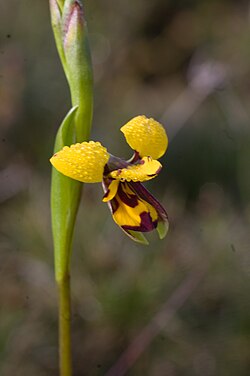Biology:Diuris septentrionalis
| Northern bee orchid | |
|---|---|

| |
| Near Wubin | |
| Scientific classification | |
| Kingdom: | Plantae |
| Clade: | Tracheophytes |
| Clade: | Angiosperms |
| Clade: | Monocots |
| Order: | Asparagales |
| Family: | Orchidaceae |
| Subfamily: | Orchidoideae |
| Tribe: | Diurideae |
| Genus: | Diuris |
| Species: | D. septentrionalis
|
| Binomial name | |
| Diuris septentrionalis | |
Diuris septentrionalis, commonly known as northern bee orchid,[2] is a species of orchid that is endemic to the south-west of Western Australia. It has two or three linear leaves and up to five yellow flowers with dark red markings.
Description
Diuris septentrionalis is a tuberous, perennial herb with two or three linear leaves 80–200 mm (3.1–7.9 in) long and 1.8–2.2 mm (0.071–0.087 in) wide. Up to five yellow flowers with dark red markings, 25–30 mm (0.98–1.18 in) long and 12–15 mm (0.47–0.59 in) wide are borne on a flowering stem 180–400 mm (7.1–15.7 in) tall. The dorsal sepal is tapering egg-shaped to elliptic, 10–15 mm (0.39–0.59 in) long and 5–7 mm (0.20–0.28 in) wide. The lateral sepals are parallel or crossed near the tip, 10–18 mm (0.39–0.71 in) long, 1–3 mm (0.039–0.118 in) wide and project forwards. The petals are paddle-shaped, the blades elliptic to egg-shaped or round, 8–13 mm (0.31–0.51 in) long and 5–9 mm (0.20–0.35 in) wide on a reddish-brown stalk 3–6 mm (0.12–0.24 in) long. The labellum is 8–14 mm (0.31–0.55 in) long with three lobes - the centre lobe broadly wedge-shaped to heart-shaped, 8–12 mm (0.31–0.47 in) long and 7–10 mm (0.28–0.39 in) wide. The side lobes spread widely apart and are oblong, 4–7 mm (0.16–0.28 in) long and 2.0–4.5 mm (0.079–0.177 in) wide. There are two smooth calli ridges outlined with red near the mid-line of the labellum. Flowering occurs in August and September.[3][4][5]
Taxonomy and naming
Diuris septentrionalis was first formally described in 2013 by David Jones and Christopher J. French in Australian Orchid Review, from a specimen collected by French in 2001.[6] The specific epithet (septentrionalis) means "north" or "northern", referring to the distribution of the species.[4]
Distribution and habitat
Northern bee orchid grows in winter-wet shrubland between Regans Ford and areas inland from Kalbarri in the Avon Wheatbelt, Geraldton Sandplains, Jarrah Forest, Swan Coastal Plain bioregions of south-western Western Australia.[2][3][4]
Conservation
Diuris septentrionalis is listed as "not threatened" by the Western Australian Government Department of Biodiversity, Conservation and Attractions.[2]
References
- ↑ "Diuris septentrionalis". Australian Plant Census. https://biodiversity.org.au/nsl/services/apc-format/display/236286.
- ↑ 2.0 2.1 2.2 "Diuris septentrionalis". FloraBase. Western Australian Government Department of Parks and Wildlife. https://florabase.dpaw.wa.gov.au/browse/profile/42228.
- ↑ 3.0 3.1 Brown, Andrew; Dixon, Kingsley; French, Christopher; Hopper, Stephen (2008). Orchids of Western Australia. Crawley, Western Australia: University of Western Australia Press. p. 229. ISBN 9780980348149.
- ↑ 4.0 4.1 4.2 Jones, David L.; French, Christopher J. (2013). "The characterisation of Diuris laxiflora Lindl. and the description of four new allied species from Western Australia". Australian Orchid Review 78 (1): 24–25. https://www.biodiversitylibrary.org/item/310584#page/26/mode/1up. Retrieved 15 August 2023.
- ↑ Hoffman, Noel; Brown, Andrew (2011). Orchids of South-West Australia (3rd ed.). Gooseberry Hill: Noel Hoffman. p. 483. ISBN 9780646562322.
- ↑ "Diuris septentrionalis". APNI. https://id.biodiversity.org.au/instance/apni/761663. Retrieved 15 August 2023.
Wikidata ☰ Q26160797 entry
 |

